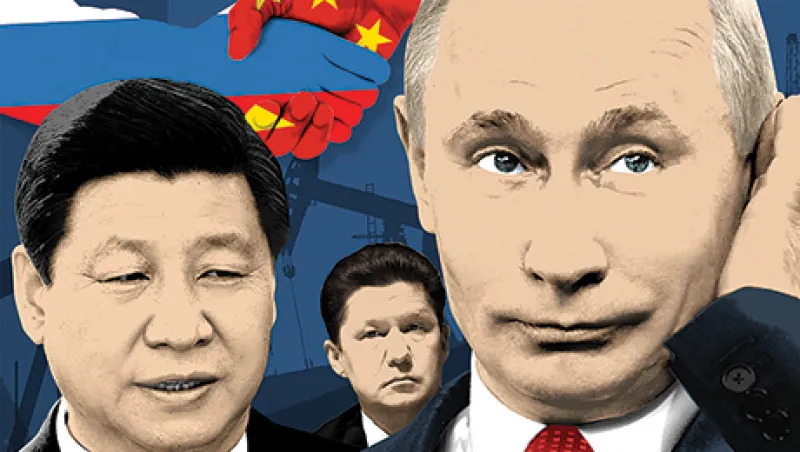Russian President Vladimir Putin grabbed the world’s attention last month with his well-timed diplomatic initiative on Syrian chemical weapons. The groundwork for that masterstroke was laid when his U.S. counterpart, Barack Obama, and other global leaders visited St. Petersburg for a Group of 20 summit in early September. Yet Putin was simultaneously holding other talks that were much more important for Russia in the long term. His interlocutor was new Chinese President Xi Jinping, and the subject was fueling China’s future with Russian energy. Both leaders looked on September 5 as Alexey Miller and Liao Yongyuan, the heads of Russia’s state-owned Gazprom and China National Petroleum Corp., respectively, signed an agreement meant to guarantee huge quantities of East Siberian natural gas to China for decades. A statement from Gazprom said the accord “defines the volumes, start of deliveries, and payments.”
Gazprom’s battered shares, which are trading at a mere three times estimated 2013 profit, jumped 13 percent in a week after the announcement, to 148 rubles ($4.57) on Russia’s Micex exchange. “The chances of signing a final deal are high,” says Valery Nesterov, an oil and gas analyst with Sberbank CIB in Moscow.
But Russian and Chinese trade negotiators aren’t hasty. Talks between Gazprom and CNPC have dragged on since 2004 despite the synergies of linking the world’s largest natural-gas reserves to its fastest-growing major economy. “It seems to me they just signed the same letter of intent they sign every year,” quips Tom Adshead, a portfolio manager at Moscow-based Verno Capital.
The perennial roadblock has been price. Gazprom wants China to pay the same $400 or so per 1,000 cubic meters that it gets from European customers, and to link gas and oil prices in a similar way. China is bargaining for about $300, offering to make up part of the difference with low-interest loans for Gazprom’s multibillion-dollar pipeline construction, Sberbank’s Nesterov says. Beijing would also prefer to tie its tariffs to spot natural-gas prices, which shale gas drilling has been pushing down, especially in the U.S.
Now a new obstacle looms, says Jonathan Stern, head of natural-gas research at the Oxford Institute for Energy Studies. China is quietly angling for an equity stake in the Russian fields and pipeline that would deliver its future fuel supply. That sort of sharing is anathema to Gazprom, which jealously guards its monopoly on the Russian pipeline network. “We are beginning to see a clash of corporate cultures that are completely opposite to each other,” Stern remarks. “Discussions on that aspect are just starting up, and they could take years more.”
As if to underline how the Chinese model works, President Xi stopped off in Turkmenistan on his way to the G-20 and cut the ribbon on the world’s second-biggest gas field, which is financed and operated by CNPC. By 2020 the arid Central Asian country may supply China with 65 billion cubic meters of gas annually. “The longer talks go on, the more alternatives the Chinese find to Gazprom’s pipeline gas,” says Stern.
Gazprom has leverage of its own, though, Verno’s Adshead notes. Demand is reviving in Europe, and Japan’s nuclear energy problems have it clamoring for the liquefied natural gas that Gazprom produces on Russia’s Pacific coast.
Other Russian energy companies are finding it easier to get to yes with Beijing. Novatek, Gazprom’s privately owned upstart rival, had a more low-key announcement of its own during the G-20 conclave: It signed a memorandum of understanding with three Chinese state banks to help finance its $20 billion LNG project in the Arctic. CNPC is already an equity partner there, and a supply deal is expected once the complex comes online in 2016.
State-owned oil champion Rosneft dwarfed that transaction in June, inking a pact to supply China with $275 billion worth of crude over the next 25 years. Sales will reach an impressive 600,000 barrels per day later this decade. The deal included a Chinese prepayment of at least $60 billion to slash the leverage that Rosneft took on for its recent $55 billion acquisition of Russian oil company TNK-BP — effectively the financing-for-price-cut trade that CNPC seeks with Gazprom.
Putin has already made much progress in opening an eastern front for Russia’s mineral wealth, an effort that began in the mid-2000s and accelerated after the 2008 financial crisis. Trade with China grew 11 percent last year, to $88 billion, making Russia’s southeastern neighbor its largest partner excluding the European Union. With Gazprom, the next giant step looks within reach. But the Kremlin boss may have to persuade the company hierarchy to be a little less stubborn.
Read more on banking and capital markets.






